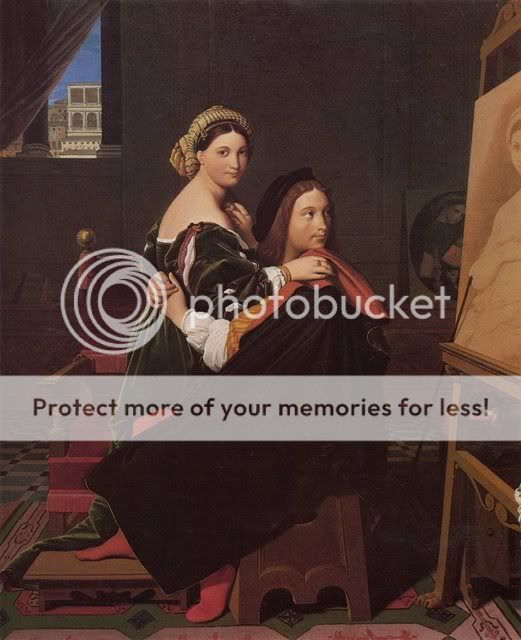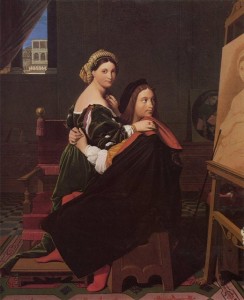Art Weekend Mystery 01/18/09: Who was The Fornarina ?
Raphael and the Fornarina, 1814
Jean Auguste Ingres
Oil on canvas
Ingres’ imaginary double portrait (shown above), Raphael and La Fornarina (1814), which shows the dark-eyed lady perched on the artist’s lap, helped turn Raphael’s painting into a cult icon.
The scenario also caught Picasso’s interest; in 1968 he made a series of drawings of Raphael and his lover caught in flagrante by the pope, sometimes with Raphael’s rival, Michelangelo, peeking out from under the bed.

Raphael and the Fornarina close-up
by Jean Auguste Ingres, 1814

Left: La Fornarina by Raphael, 1518
The rumor that La Fornarina (left) is a portrait of Raphael’s mistress began in the Renaissance, but it wasn’t until the 19th century that the story really captured the popular imagination.
It is housed in the Galleria Nazionale d’Arte Antica in Palazzo Barberini, Rome.
It is probable that the picture was in the painter’s studio at his death in 1520, and that it was modified and then sold by his assistant Giulio Romano. In the 16th century the picture was in the house of the Countess of Santafiora, a Roman noblewoman, and subsequently became property of the Duke Boncompagni and then of the Galleria Nazionale which still possesses it.
The woman is traditionally identified with the fornarina (bakeress) Margherita Luti, the semi-legendary Roman lover of Raphael, though, probably, the true meaning of the picture has still to be cleared up. The woman is pictured with an oriental style hat and bare breasts. She is making the gesture to cover her left breast, or to turn it with her hand, and is illuminated by a strong artificial light coming from the external. Her left arm has a narrow band carrying the signature of the artist, RAPHAEL URBINAS. Art historians and scholars debate whether the right hand on the left breast reveal a cancerous breast tumour detailed and disguised in a classic pose of love. The particular fixed glance of the young woman also contributes to the artificiality of the whole composition.
So, is this romantic story fact or fiction? The experts are divided.
When La Fornarina was shown in a special exhibition in Rome in 2000, the curators presented X-rays of the painting, which reveal a quickly executed underdrawing, most likely done from life. X-Ray analysis have shown that in the background was originally a Leonardesque-style landscape in place of the myrtle bush, which was sacred to Venus, goddess of love and passion.
Since nude models were hard to come by in 16th century Italy, they argued, Raphael must have been on very intimate terms with the sitter, so they conclude that La Fornarina was Raphael’s lover, Margherita Luti.
On the right side of the first painting above, “Raphael and the Fornarina” by Ingres, there is an easel in the painting. If you look at the easel, you can see the impression of the second painting, “La Fornarina” by Raphael.
|
starfishred wrote on Jan 16, ’09
Ingres probably made her in the immage of the Raphael thanks great post
|
|
lauritasita wrote on Jan 17, ’09
I looked at the first painting and I thought, “Well, that’s a sight you don’t see everyday in that art period.”
|
|
forgetmenot525 wrote on Jan 24, ’09
seem to have missed this too……………..what a very intriguing painting……………so unusual for the period, strange how he is looking at his canvas but she is looking directly at ‘us’…………beautifully painted though.
|
|
lauritasita wrote on Jan 24, ’09
Isn’t it unusual ? I thought the same thing.
|


Comments
Art Weekend Mystery 01/18/09: Who was The Fornarina ? — No Comments
HTML tags allowed in your comment: <a href="" title=""> <abbr title=""> <acronym title=""> <b> <blockquote cite=""> <cite> <code> <del datetime=""> <em> <i> <q cite=""> <s> <strike> <strong>